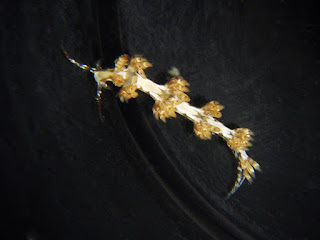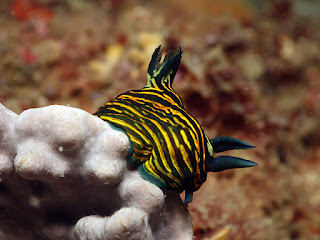Julie, Terry and David on this excursion consisting of 1 x 83 minute and 1 x 85 minute dives in water depths of 11 m to 14 m. 6 m viz, 18 C water temp and some surge. We all agreed that the drysuit is the best invention ever.
Once more the island beckoned. With the NW wind forecast to strengthen we opted to dive on the SE corner at a site we call Bornella Reef. Whilst there were hydroids present alas the Bornella specimens that gave their name to the site were not. Two specimens of Tambja victoriae were sighted one of which at 60 mm was amongst the largest we have observed in these waters. Favorinus sp. 1 popped up again. It has been placed in this genus for the sole reason that the rhinophores have cup-shaped annulations but the cerata do not seem typical.
Number of each species sighted: 1st dive/2nd dive
* Species with highest specimen count
Bulbaeolidia alba 1/-
Cadlinella ornatissima -/1
Dermatobranchus cf. primus 1/-
Favorinus sp. 1 1/-
Flabellina rubrolineata 1/1
Flabellina sp. 1 1/2
Goniobranchus cf. reticulatus -/1
Goniobranchus daphne 1/-
* Goniobranchus splendidus 7/9
Goniodoridella savignyi -/2
Hypselodoris jacksoni 1/1
Hypselodoris obscura -/2
Jorunna sp. 3 1/-
Phyllidia exquisita -/1
Phyllidia ocellata 1/-
Phyllidiella pustulosa 2/-
* Pteraeolidia ianthina 14/2
Roboastra luteolineata -/1
Tambja victoriae -/2
Thuridilla splendens 1/2
Trinchesia ornata -/1
Trinchesia sibogae 1/-
Surface conditions at the island
Hypselodoris jacksoni
Phyllidia exquisita - or is it?
Yes! Note the gold edge to the mantle margin
Tambja victoriae
Healthy substrate
Goniobranchus splendidus - hard to believe
they could match the Pteraeolidia ianthina in numbers
Hypselodoris obscura
Cadlinella ornatissima
Favorinus sp. 1
Dermatobranchus cf. primus
Goniobranchus daphne
Pteraeolidia ianthina - numbers were
higher on the one side of of the reef finger
Trinchesia ornata
Roboastra luteolineata
Goniodoridella savignyi
Thuridilla splendens
Flabellina sp. 1


















